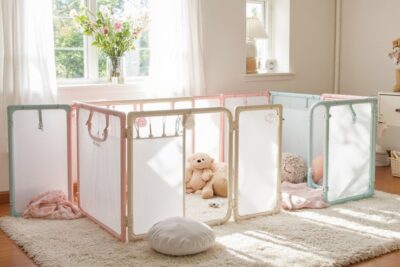
What Makes a Playpen Safe for Babies?
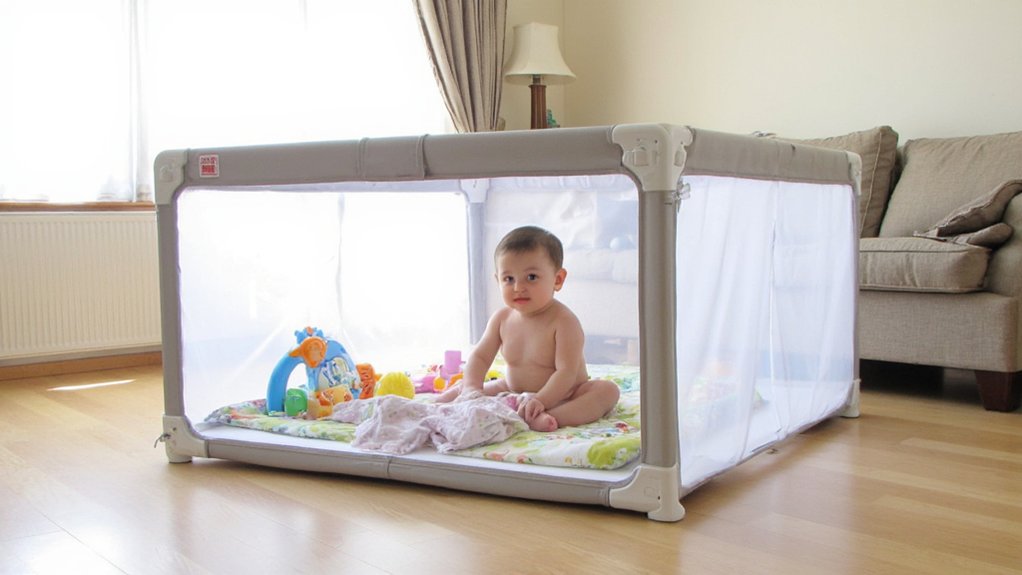
You make a playpen safe for your baby by choosing one with JPMA certification and secure locking mechanisms placed out of reach. Verify it’s made from non-toxic materials with mesh sides smaller than ¼ inch to prevent entrapment. The sides should be at least 20 inches high for climbing safety, and the mattress must fit snugly and be firm. Keeping the area hazard-free and regularly inspecting for wear or damage is key. Understanding these basics helps you create a safer play area.
Table
- Main Points
- Essential Safety Standards and Certifications
- Ideal Materials and Construction Features
- Proper Dimensions and Mesh Requirements
- Mattress and Padding Safety Guidelines
- Secure Locking Mechanisms and Stability
- Placement and Environmental Safety Considerations
- Regular Maintenance and Inspection Practices
- Frequently Asked Questions
- Final Thoughts
Main Points
- Ensure the playpen has JPMA certification and sides at least 20 inches high to meet safety standards and prevent climbing.
- Use non-toxic materials with tightly spaced mesh openings smaller than ¼ inch to avoid head entrapment.
- Equip the playpen with secure, out-of-reach locking mechanisms and stable construction to prevent accidental openings and tipping.
- Provide a firm, snug-fitting 1-inch mattress without extra bedding to reduce suffocation risks.
- Regularly inspect the playpen’s mesh, locks, slats, and surroundings to maintain a hazard-free, safe environment.
Essential Safety Standards and Certifications
When choosing a playpen, you should prioritize those with JPMA certification, as it guarantees compliance with rigorous safety standards for materials and design.
This certification confirms the playpen creates a secure play environment, protecting babies from potential hazards. Pay close attention to the height of the sides—at least 20 inches—to prevent climbing out. Many modern playpens also feature stable suction cups to keep the structure firmly in place during active play.
The mesh openings must be smaller than ¼ inch to avoid head entrapment, while wooden slats should be spaced no more than 2-3/8 inches apart.
Check that all padded areas are intact and free from tears to eliminate risks of bumps or suffocation. Additionally, locking mechanisms should be out of the baby’s reach and top rails must automatically lock when lifted.
Using Safe Materials and adhering to these safety standards will help you provide the safest playpen for your little one.
Ideal Materials and Construction Features

Choosing a playpen that meets safety certifications like JPMA is a strong start, but understanding the materials and construction features is just as important for your baby's protection.
Opt for non-toxic materials such as New Zealand pine wood, safe for teething, or plastic certified by CPC or CPSIA to avoid harmful chemicals like BPA. For added peace of mind, look for playpens that feature transparent 360° breathable mesh panels to provide visibility and ventilation while keeping your baby secure.
Choose playpens made from non-toxic New Zealand pine or CPC/CPSIA-certified plastic to ensure safety from harmful chemicals.
The construction features should include rounded corners and anti-slip bases to reduce potential hazards like bumps or tipping.
Verify slat spacing is narrow enough to prevent head entrapment, keeping your baby comfortable and safe.
Durable, water-resistant surfaces make cleaning easier, maintaining hygiene.
By prioritizing these materials and construction elements, you’ll provide a secure environment that aligns with safety certifications and supports your commitment to your baby’s well-being.
Proper Dimensions and Mesh Requirements

Guaranteeing a playpen has proper dimensions and mesh requirements is essential for your baby's safety and comfort. The sides should be at least 20 inches high to prevent your child from climbing out.
When it comes to mesh requirements, holes mustn't exceed ¼ inch to avoid head entrapment. For wooden playpens, slat spacing should be no more than 2-3/8 inches.
Importantly, the mesh must be securely attached to both the top rail and floor plate to maintain stability and prevent injuries. Regularly inspect the mesh for tears, holes, or loose threads, as these can create safety risks.
By adhering to these proper dimensions and mesh standards, you guarantee a secure environment that protects your baby effectively.
Mattress and Padding Safety Guidelines
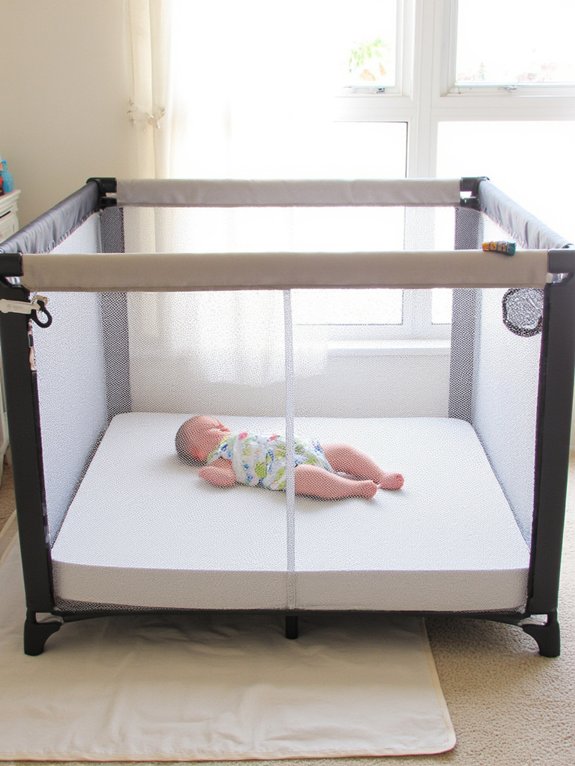
Although a soft surface might seem comfortable, you should use only a firm 1-inch mattress or pad at the bottom of the playpen to provide a safe sleeping environment for your baby.
This firm mattress or pad must fit snugly to eliminate gaps that could create suffocation hazards. Avoid adding extra bedding or pillows, as multiple layers increase risk. For added peace of mind, look for a playpen that uses non-toxic materials in its mattress and padding construction.
Always choose padding made from non-toxic materials to protect your baby’s health. Regularly inspect the mattress and padded areas for tears or damage, repairing them promptly to maintain safety.
By adhering to these mattress and padding safety guidelines, you’ll create a secure space that minimizes suffocation hazards and guarantees your baby rests safely and comfortably.
Prioritizing these details reflects your commitment to your child’s well-being.
Secure Locking Mechanisms and Stability
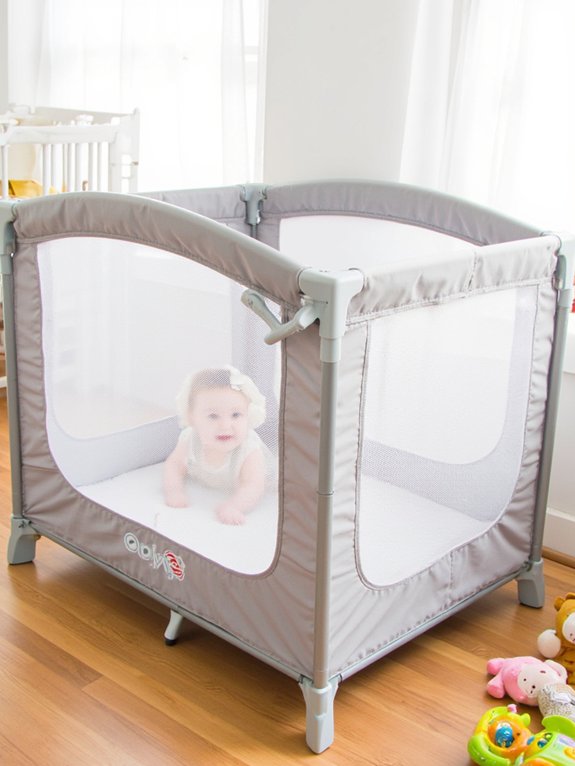
Check that the playpen’s locking mechanisms are securely positioned out of your baby’s reach to prevent accidental openings.
Secure locking mechanisms, especially those with automatic locks that engage when the sides are lifted, provide essential safety by preventing unintended collapses.
You should regularly inspect these locks to verify they function properly, with no loose or broken parts.
Stability is equally important; a stable playpen resists tipping or wobbling, keeping your baby safe to play.
Verify the playpen is assembled on a flat surface and features reinforced joints and sturdy materials.
Many modern playpens, like the Pamo Babe Portable Playpen, are constructed with non-toxic materials and secure locks to meet safety standards and provide parents with peace of mind.
These design elements enhance overall stability, allowing the structure to withstand your child’s movements.
Prioritizing secure locking mechanisms and stability guarantees a safe environment where your baby can explore with confidence.
Placement and Environmental Safety Considerations
You should place the playpen in a visible, flat area to guarantee you can supervise your baby easily and prevent tipping.
Keep it away from windows and remove any nearby cords or hazards to eliminate risks like strangulation or falls.
Regularly check the surrounding space to maintain a safe, hazard-free environment that supports your baby’s safety.
For added security, consider playpens with anti-slip bases to enhance stability and reduce the risk of movement during playtime.
Ideal Location Selection
Selecting the right location for your baby’s playpen involves several critical safety considerations to create a secure environment.
The ideal location selection guarantees your baby stays safe and comfortable during playtime. To maintain a safe environment, focus on these key points:
- Place the playpen on a flat stable surface to prevent tipping or wobbling that could cause injuries. Choosing a spot where suction cups enhance stability can further reduce the risk of movement or sliding.
- Position the playpen away from windows, cords, curtains, and heat sources to eliminate strangulation and burn risks.
- Remove any toys or objects with sharp edges near the playpen, and keep the surrounding area clear of hazards your baby could reach or climb on.
Hazard-Free Surroundings
When placing a playpen, ensuring a hazard-free environment is essential to your baby’s safety and comfort.
Always set the playpen on a flat, stable surface to guarantee stability and prevent tipping. Position it away from windows, cords, curtains, and heaters to reduce risks of strangulation and burns. Choosing a playpen with a secure locking door and proper panel spacing can further reduce risks by preventing your child from accessing unsafe areas.
Keep the surrounding environment free from small objects or furniture that your child might use to climb out. Regularly inspect the area for sharp edges or loose items that could pose dangers.
Additionally, maintain clear visibility of the playpen from common areas to allow for continuous supervision.
By thoughtfully managing these placement and environmental safety considerations, you create hazard-free surroundings that protect your baby and support your caregiving efforts effectively.
Regular Maintenance and Inspection Practices
Although a safe playpen starts with quality design, regular maintenance and inspection are vital to keep it secure over time.
A safe playpen begins with good design but relies on regular maintenance and inspections to stay secure.
As your child explores, you must guarantee the playpen’s mesh, structure, and components remain intact and hazard-free.
Follow these key steps:
- Inspect the mesh for tears, holes, or loose threads to prevent entrapment hazards and guarantee breathable safety.
- Check wooden slats to confirm spacing doesn’t exceed 2-3/8 inches, reducing head entrapment risks.
- Verify all locks and latches work properly and stay out of your child’s reach, preventing accidental openings.
Regular maintenance also includes examining padding and tightening hardware to maintain stability.
Consistent inspection helps you provide a safe environment where your child can confidently explore.
Frequently Asked Questions
What Are the Safety Standards for Playpens?
You must guarantee playpens meet safety regulations, include tested materials, and feature secure locks. Follow age recommendations closely, and look for testing certifications like JPMA to ensure your playpen protects and serves your child safely.
Is a Playpen Safe for Babies?
Long before smartphones, you’d trust baby playpen features like secure locking and size guidelines. Follow playpen age recommendations, prioritize material safety, and use playpen usage tips to guarantee your little one’s safety every time.
How to Make a Safe Play Area for Baby?
To create a safe play area for your baby, follow baby proofing tips by choosing soft flooring options, providing safe toys, including play area essentials, and maintaining constant supervision practices to guarantee your little one explores securely and happily.
Is Montessori Against Playpens?
Like a gentle guide, Montessori principles encourage safe exploration and independent play, favoring playpen alternatives that support child development. You’ll find playpens serve well only when they promote autonomy and respect your child’s natural curiosity.
Final Thoughts
You want a playpen that’s as secure as it is comfortable—sturdy materials paired with breathable mesh, firm padding alongside soft edges. While certifications prove safety, your vigilance in placement and maintenance seals the deal. Neglecting these can turn a safe haven into a hazard. By balancing strict standards with attentive care, you create a space where your baby can explore confidently, giving you peace of mind backed by evidence and expertise.
 34 Best Cribs of 2025 for Safe and Stylish Baby Sleep Spaces
34 Best Cribs of 2025 for Safe and Stylish Baby Sleep Spaces 15 Best Baby Crib Mattresses for Safe and Comfortable Sleep in 2025
15 Best Baby Crib Mattresses for Safe and Comfortable Sleep in 2025If you want to know other articles similar to What Makes a Playpen Safe for Babies? you can visit the Play Yards & Playpens category.

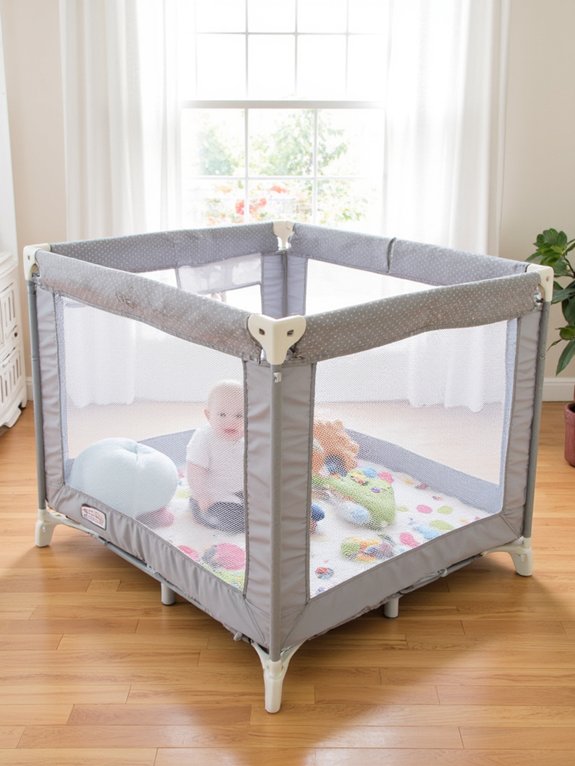
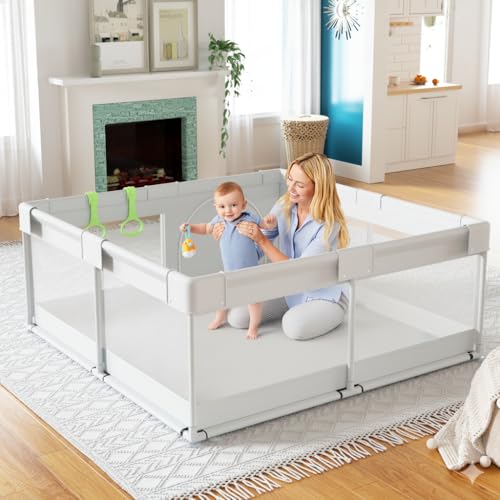









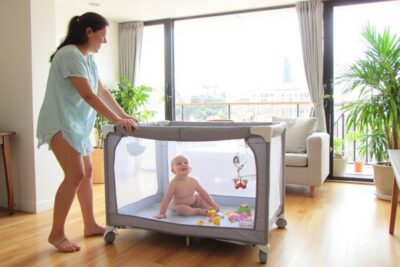

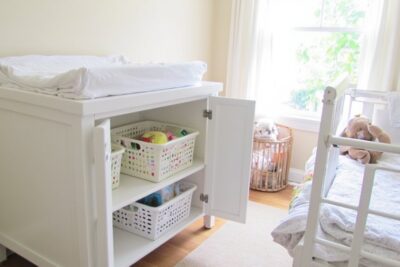
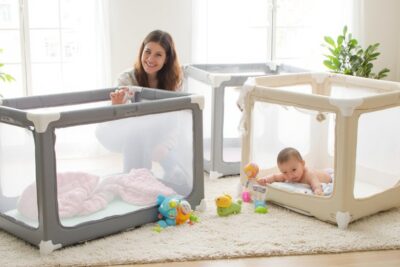



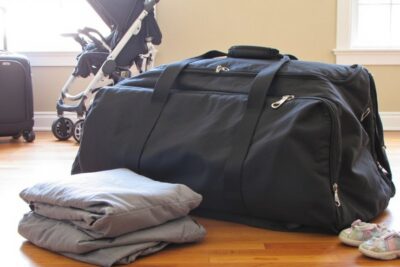
This is also interesting